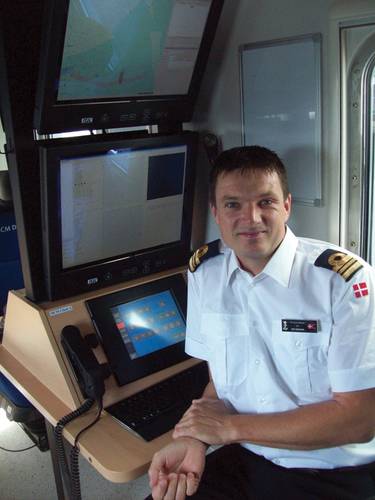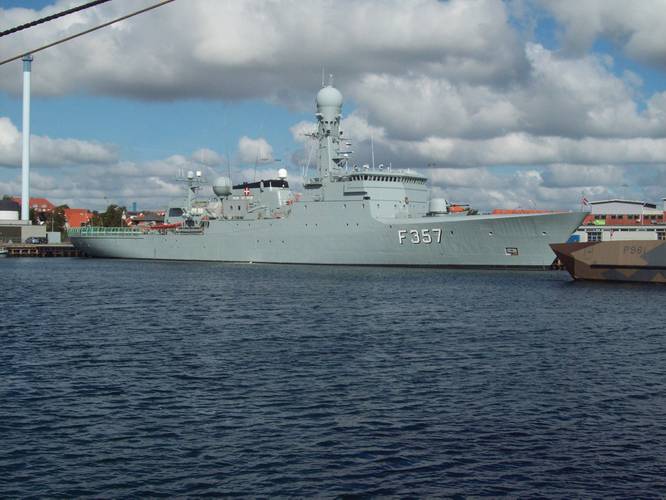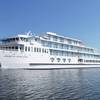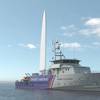A Boxed Set In Denmark Mine Warfare Capability Comes as a Boxed Set
The Danish Navy is the expert when it comes to flexible, modular combat capability. It created the StandardFlex modules for the Flyvefisken class of patrol vessels in 1995 that was built specifically to operate with the containerized modules. But Denmark is no longer facing a Cold War threat to its waters. Instead, it is assuming a broader role involved in international partnerships and coalitions. The Flyvefisken-class has been retired. Today, the new ships of the Danish Navy, including the Absalon class of flexible support ships, Iver Huitfeldt-class-frigates and Knud Rasmussen-class Arctic patrol vessels are all designed for combat capability in containers. In some cases, they are the very same containers that sailed about the Flyvefisken-class.
Mine warfare is still important to Denmark. So while the Flyvefisken-class fitted out with MCM mission packages is no longer operating for the Danish Navy, the capability is still available to be utilized aboard other platforms.
Lieut. Cmdr. Kristian Hansen is the commanding officer of MCM Denmark, and is responsible for mine countermeasures against mines and ammunition at sea. The Danish Navy uses containerized command and control (C2) facilities, diving equipment, specialized surface craft and unmanned underwater vehicles to conduct mine warfare as part of MCM Denmark. “We conduct operations to fulfill our national and international obligations,” Hansen says. “But we must be able to do our own MCM in home waters.” The last of the Flyvefisken-class STANFLEX 300 ships, which performed mine warfare missions, were decommissioned three years ago. Today, the Danish Navy has taken a new approach to mine warfare.
Hansen’s MCM Denmark command includes the MCM Staff, and two 14-person detachments, Team Alfa and Team Bravo. It includes specialized ships, 20-foot containers with command and diving capabilities, and their offboard systems to find and destroy mines. “I am in command of all the people, the containers, the ships, and the systems.”
The MCM system is operated from a 20-foot C2 module, which can be fitted aboard a host ship. For the purpose of the recent DANEX / NOCO 2012 exercise, Hansen’s command center —along with a diving module—is aboard HDMS Thetis, one of Denmark’s inspection frigates used for patrolling the remote waters around Greenland and the Faeroe Islands. “These two containers, one on each side of Thetis, are the only two we have at the moment.”
The command can provide four different packages. It can bring the entire package with the CTU (commander task unit) staff, along with its command module and diving module, as well as the MSF ships with sidescan sonar and the MSD ships with the remotely operated vehicle (ROV), called the mine demolition vehicle (MDV).
“With package 2 we can operate from another platform, without the staff or command module,” Hansen says. “With the third package, we can place the module on land and operate from shore. We work with Danish EOD, who can work in very shallow water, inside the harbor, for example, while we use our vehicles outside the harbor within the approaches to the port, with command and control from land. Our fourth option is to bring our MSD or MSF ships to operate independently.” In that case, we’re on our own,” Hansen says. The ships have a range of about 500 miles. If needed outside of Danish waters, it’s possible to transport them on a heavy lift ship for international operations. The MSD and MSF ships are small but have comfortable accommodations. The CO has a single, all other s are two bunks to a stateroom. They have a small galley for “self cooking.”
Remote Control of Mine Hunting Vessels
MCM Denmark currently has two MSDs and four MSFs. The 95-foot, 98-ton MSDs each carries a remotely operated MDV. They are known as the Holm class, with the two ships being the Hirsholm and Saltholm. The MSF is 104 tons and 79 feet long.
The MSDs and MSFs can work in teams, directed by the command element in the modules aboard ship. Both the command and diving module can be installed on the Absalon, Thetis, Sea Supply, Knud Rasmussen- classes, the transport HDMS Sleipner, chartered vessels fitted with container positions, or mounted on trucks. The C2 container can control up to two MSFs at one time, and each MSD can control one MSF at a time. “We can link the MSF with the MSD up to about 16 km. With a satellite we can get a better link, and operate a further distance from the mother vessel and keep us out of the danger areas,” says Hansen. The ships can operate with all-enlisted crew. “The crew members are familiar with all of the boats, and could go out on any one of them based on mission requirements and crew and vessel availability.”
The boats have a pair of 8-cylinder Skandia diesels, as well as two auxiliary diesels, and two Azipod propulsion systems. “On a good day we can do 13 knots, but we usually do 10 knots,” he says. “We’re looking at a system with less noise,” Hansen says.
The ships are made from composite material, but they have degaussing system to compensate for any magnetic metallic objects on board.
The last of the 14 StandardFlex patrol vessels to serve in the Danish Navy is HDMS Søløven is now an unarmed diving support vessel.
The slightly smaller MSF tows a side scan sonar, which remains at a depth of 6 to 9 meters above the sea floor. There is a blind spot directly beneath the vehicle, but the sonar can provide an image of the bottom for between 45 to 90 meters on either side of the 8 meter blind swath where the sonar can’t see.
According to Hansen, the system can provide a “Q route”—a path that is free from mines that ships can follow— in several passes.
“We can classify contacts from the sidescan sonar picture on the MSD or onboard the C2 container. After classification we use the tethered Saab Double Eagle 2S ROV from the MSD for identification. “The ROV are able to provide us with live video and sonar images during identification. We’re happy with the Double Eagle MKIIS. It’s amazing what it can do,” he says. “We’re also looking at autonomous solutions.”
Saab is the underwater integrator. “The integration works quite well,” Hansen says. “We’re happy with it.”
Once we identify and classify a contact and send that information to the MSD, the MSD will launch the MDV (mine disposal vehicle), which will take a picture of it with its nose mounted sonar and camera. The MDV can carry and deliver the Nordic Defense Industries DAMDIC (Danish Mine Disposal Charge), a command detonated 30kg explosive charge that destroys the mine.
“We use the ROV to carefully drop the DAMDIC close to the bottom mine. Then we get the ROV clear of the area, about 250 to 300 meters, and detonate the charge, which detonates the mine.
There are five COTS windows-based work stations aboard the MSD. “The ship has the same consoles as in the command module,” Hansen says. “Controlling drones can be accomplished from any of the work stations on the ship.”
The crew on the MSD can monitor engine temperature, oil pressure and fuel levels, turn the lights on and off on the MSF, all remotely. “We practice operating them in remote. If we are controlling two drones, we need five people. If we have just one drone, we can do it with four. We even transit to our operating area with the MSFs unmanned and under remote control because it’s more comfortable for the crew to be on the other ships,” he says.
“You need the crew on the MSF to launch the offboard vehicle, but then you can take the crew off and put them on the MSD or Thetis and they can operate the vehicle remotely,” he says. “That’s modularity.” “We have to maneuver the vehicle it back to the ship without hitting anything,” he says. “To recover the vehicle, the ship has to remain steady. It’s quite doable in seas up to a meter and a half. To help identify mines or mine-like objects, the MCM team can submit data to the Mission Support Center ashore, and its extensive database.
Diving container
The other module installed aboard Thetis for DANEX / NOCO 2012 is the diving module. “It’s built to accommodate four divers with all of their gear and support equipment. But we currently have seven. They use the Interspiro IIS-MIX rebreather developed for MCM diving. It’s non-magnetic and weighs less than 12 lbs. The tanks are all composite, made from Kevlar. All of the gear—from the diving knife to the wetsuit zipper—is also non-magnetic, made from plastic, rubber or titanium. The container itself is temperature and light controlled inside to protect the equipment from the elements and deterioration. “The ultraviolet rays would harm the rubber.”
We always used mixed gas for MCM diving. We have two mixtures we use. Red is the standard Navy mixture, but we can also use Green mixture. It depends on how deep you’re going to go.
Divers were involved in the design and construction of this container. “This container is made for diving. MCM and EOD divers have had input from the beginning. The MSF and MSD can transit to a mission area, and the MSF it can go into or on top of an unknown minefield, as far as our link-distance permits—six to nine nautical miles—and search an area with sidescan sonar. When we have a picture of all the objects on the ocean floor and have located a mine we launch the MDV from the MSD from a distance that is safe as possible for all personnel.
Hansen says the training environment in in and around Denmark is very challenging, but realistic. “We can train with WWII mines here. There are lots of mines here to practice on, but we also need to work with the newer threats that we can expect to see in real-world operations. The DANEX/NOCO 2012 exercise was successful, he says, and the MCM Denmark concept development is processing very well. The modules aboard Thetis performed well, as did the remote operation of the MSFs. “We are getting better every time we go to sea. We are very pleased. It was good, realistic training. As we were also conducting operations as part of the Baltic Ordnance Safety Board (BOSB) ongoing MCM operation in Baltic region, we not only located and destroyed three exercise mines, but 10 WWII mines, as well.” Hansen says this is an interesting time in the Danish Navy and MCM. “There are a lot of new systems and concepts.” And, he says, even though mine warfare is slow warfare, it’s going quite quickly for the people doing it. “Things are happening very fast on these small ships.”
(As publsihed in the November 2012 edition of Maritime Reporter - www.marinelink.com)

















